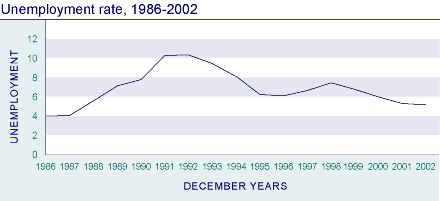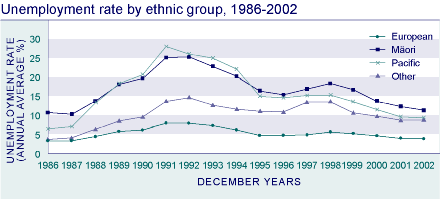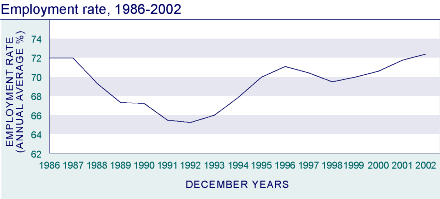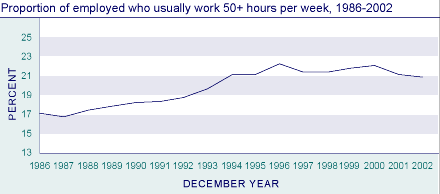Paid Work
Desired Outcomes
All people have access to meaningful, rewarding and safe employment. An appropriate balance is maintained between paid work and other aspects of life.
Introduction
Paid work has an important role in social wellbeing by providing people with incomes to meet their basic needs and contribute to their material comfort, as well as by giving them options for how they live their lives. Paid work is also important for the social contact and sense of self-worth or satisfaction it can give people.
The desired outcomes highlight three aspects of paid work: access to work, quality of work, and the balance between work and other areas of life.
For most people, income from paid work is the main factor determining their material standards of living. On average, about two-thirds of total household income is derived directly from labour market income and the figure is substantially greater for most households28. Income saved during working life contributes to the standard of living of many retired people.
The social and personal dimensions of paid work are equally important. Ideally, work should be not only materially rewarding but contribute to other aspects of wellbeing. Meeting challenges at work can contribute to a sense of satisfaction and self-worth. In this sense, it is important people are able to get work which matches their skills and abilities.
Social contact is an important part of wellbeing. For many people, much of their social contact is through their jobs. People often gain a sense of belonging or identity from their jobs, recognising themselves and others because of the organisation they work for or the type of work they do.
Conversely, unemployment can isolate people from society and cause them to lose self-confidence. Unemployment is associated with poorer mental and physical health, and lower levels of satisfaction with life.
By highlighting that all people should have access to paid work, the desired outcomes raise equity issues. Wellbeing is reduced when people feel they are suffering from discrimination or are not getting a 'fair go'.
The quality of work is of critical importance. A meaningful job can enhance people's satisfaction with their work. An unsafe job, on the other hand, places people's wellbeing at risk.
Work can also be stressful. People may be required to work longer hours than they want or need to. The desired outcomes acknowledge wellbeing is best served by maintaining a balance between paid work and other aspects of life, though where that balance lies will differ from person to person. The reference to work/life balance is new for The Social Report 2003.
Indicators
Four indicators are used in this chapter. They are: the unemployment rate; the employment rate; the proportion of the population in paid employment who work more than 50 hours a week; and the number of workplace injury claims.
Together, these indicators present a picture of people's access to employment, the level of safety of employment and the balance between work and other areas of life. The indicators do not directly measure how meaningful and rewarding that employment is. No robust data exists on how 'good' people's jobs are or how satisfied they are in their jobs.
The first two indicators relate to the quantity of paid work on offer and taken up. This is affected by several factors, including economic conditions, investment decisions, migration flows, people's qualifications and abilities, and their decisions on how much time to allocate to paid work.
The first indicator is the unemployment rate. This measures the proportion of people who are out of work, actively seeking and available to take up work. This is a relatively narrow measure of unemployment but it accords closely with the OECD standard measure, allowing international comparisons. Information about long-term unemployment is also provided.
The second indicator is the employment rate. This provides an alternative picture of people's access to paid work, as it is influenced not only by the amount of work available but also by trends in labour force participation. The indicator measures the proportion of working-age people employed for one hour or more a week. Information is provided on the breakdown between full-time and part-time employment. This gives some indication of the types of work people are taking on and the overall level of employment.
The third indicator measures the proportion of the population in paid employment who work 50 hours or more a week. This is currently the only available data allowing some measure of the balance people have between paid work and other areas of their lives. This is a new measure for The Social Report 2003. While it measures the hours worked, it doesn't record the persistence of people working long hours or whether people are satisfied with the balance.
The fourth indicator is the rate of workplace injury claims. Workplace safety is fundamental to wellbeing. Jobs should not pose an unreasonable risk to people's lives or physical wellbeing.
Unemployment
Definition: The number of people aged 15 and over who are not employed and are actively seeking and available for paid work, expressed as a percentage of the total labour force. (The labour force is defined as those aged 15 and over who are employed, plus those who meet the definition of unemployed.)
Relevance: This is a key indicator of labour market outcomes and lack of access to employment. The unemployment rate is an important reflection of overall economic conditions and of the ease with which people are able to move into employment.
Current Level and Trends
In 2002, an average of 5.2 percent of the labour force, or 102,500 people, were unemployed and actively seeking work. The unemployment rate has steadily declined since 1998 and is considerably lower than the peak rate of 10.3 percent in 1991-1992 (almost 170,000 people unemployed), but is higher than the rate of 4.0 percent in 1986 (64,000 people unemployed).
In 2002, 29 percent of the surveyed unemployed were unemployed for a continuous period of six months or more, compared to 31 percent in 2001. The proportion of long-term unemployed was still higher in 2002 than in 1986, when it was 22 percent, but substantially lower than the peak of 53 percent in 1992-1993.
Figure PW1.1

Source: Statistics New Zealand, Household Labour Force Survey
The economy's improved performance over the last decade has contributed to the steady decline in the unemployment rate over this time. Changes in the regulation of the labour market and the benefit system may also have had some effect.29
Ethnic Differences
Substantial differences in unemployment rates persist for different ethnic groups. Since 1986, Māori unemployment has risen from 10.7 percent to a peak of 25.4 percent in 1992 and declined to 11.3 percent in 2002. Between 1986 and 1991, the unemployment rate for Pacific peoples rose from 6.5 percent to 28 percent, the highest rate for any ethnic group. However, since the mid-1990s, the Pacific unemployment rate has declined more than that of Māori, and stood at 9.2 percent in 2002.
The European ethnic group have the lowest unemployment rates; they rose from 3.2 percent in 1986 to a peak of 7.9 percent in 1992 and had declined to 3.8 percent by 2002. The unemployment rate among the 'Other' ethnic group category (which comprises predominantly people of Asian ethnicity and includes many recent migrants) increased from 3.6 percent in 1986 to 14.7 percent in 1992, and was 8.8 percent in 2002.
Figure PW1.2

Source: Statistics New Zealand, Household Labour Force Survey
Age and Sex Differences
Unemployment rates among different age groups have followed similar trends but the level among those aged 15-24 has been consistently more than twice the rate for older groups. The unemployment rate for young people averaged 11.4 percent in 2002 and this group comprised 39 percent of all unemployed. Unemployment rates for males and females are similar. In 2002, 47 percent of all unemployed were women.
Table PW1.1 Unemployment rates (%), by age and sex, selected years, 1986-2002
| Year | 15-24 | 25-44 | 45-64 | Total 15+ | Males | Females |
|---|---|---|---|---|---|---|
| 1986 | 7.9 | 3.1 | 1.7 | 4.0 | 3.5 | 4.6 |
| 1991 | 18.8 | 8.8 | 5.8 | 10.3 | 10.9 | 9.5 |
| 1996 | 11.8 | 5.2 | 4.0 | 6.1 | 6.1 | 6.1 |
| 2001 | 11.8 | 4.4 | 3.3 | 5.3 | 5.4 | 5.3 |
| 2002 | 11.4 | 4.4 | 3.1 | 5.2 | 5.1 | 5.3 |
Source: Statistics New
Zealand, Household Labour Force Survey |
||||||
Regional Differences
In 2002, regional unemployment rates were highest in Northland (8.9 percent) and Bay of Plenty (7.3 percent) and lowest in Southland and Tasman-Nelson-Marlborough-West Coast (each 3.5 percent).
International Comparison
New Zealand's unemployment rate relative to those of other OECD countries has ranged from being one of the lowest in the mid-1980s, to well above average in the early 1990s, to below average over the past three years. In 2002, New Zealand's standardised unemployment rate ranked 12th lowest and at 5.2 percent, was similar to that of the United Kingdom (5.1 percent) and lower than that of Japan (5.4 percent), the United States (5.8 percent), and Australia (6.3 percent)30. In 2001, New Zealand ranked seventh lowest in terms of the proportion of the unemployed who had been unemployed for six months or longer31.
Employment
Definition: The proportion of all people aged 15-64 years who are in paid employment for at least one hour per week.
Relevance: The employment rate is the best available indicator of the prevalence of paid employment. It captures trends in both unemployment and labour force participation (the proportion of the working age population either employed or unemployed).
Current level and Trends
In 2002, the surveyed employment rate averaged 72.4 percent of 15-64 year olds with an average of 1,835,700 people in work for one hour or more per week. This was slightly above the rates recorded in 1986 and 1987 (72 percent). The employment rate has been rising since 1992, except during the economic downturn in 1997 and 1998. The increase from 65.3 percent in 1992 to 72.4 percent in 2002 corresponds to a rise of 380,700 in the number of employed people aged 15-64. Over the same period, the number of people aged 15-64 increased by 305,400.
Full-time employment rates declined between 1986 (60.3 percent) and 1991 (52 percent) and have yet to recover to 1986 levels among men. Part-time employment rates have increased for both sexes over the period (from 11.7 percent to 16.1 percent), almost doubling among men. However, women continue to have higher part-time employment rates than men.
Figure PW2.1

Source: Statistics New Zealand, Household Labour Force Survey
Note: Based on population aged 15-64
Age and Sex Differences
The employment rate decline between 1987 and 1992 affected all age groups, but was most pronounced for young people. Youth employment rates have remained relatively low during the period of employment growth since 1992, possibly due to a growth in participation in tertiary education and training. Conversely, employment rates for people aged 45-64 have grown strongly since 1992, driven mostly by the phasing in of the higher age of eligibility for New Zealand Superannuation.
Women's employment rate is significantly lower than that of men, owing mainly to the fact women spend more time on childcare. The gap has, however, narrowed substantially since the mid-1980s, from 24 to 14 percentage points.
Table PW2.1 Employment rates (%), by age and sex, selected years, 1986-2002
| Year | 15-24 | 25-44 | 45-64 | Total 15+ | Males | Females |
|---|---|---|---|---|---|---|
| 1986 | 67.1 | 79.4 | 65.1 | 72.0 | 84.1 | 60.0 |
| 1991 | 54.3 | 74.0 | 61.7 | 65.5 | 73.7 | 57.5 |
| 1996 | 59.4 | 77.3 | 70.2 | 71.1 | 79.0 | 63.3 |
| 2001 | 56.0 | 77.9 | 73.6 | 71.8 | 78.9 | 64.9 |
| 2002 | 56.8 | 78.3 | 74.7 | 72.4 | 79.6 | 65.4 |
Source: Statistics New
Zealand, Household Labour Force Survey |
||||||
Ethnic Differences
The proportions of the European, Māori and Pacific working age populations in employment all fell between 1987 and 1992 and have risen since then. The only ethnic group to have higher employment rates in 2002 than in the mid-1980s was the European only group (77.5 percent employed in 2002, compared with 73.5 percent in 1986). The Māori employment rate, at 61.4 percent in 2002, had almost recovered to 1986 levels (61.9 percent), but Pacific people were still much less likely to be employed (67.2 percent in 1986, 59.1 percent in 2002). The employment rate for the 'Other' ethnic category has fallen from being the second highest in the late 1980s to the lowest since the mid-1990s, reflecting the difficulties experienced by some newer migrants in integrating into the New Zealand labour market.32
Figure PW2.2

Source: Statistics New Zealand, Household Labour Force Survey
Note: Based on population aged 15-64
Regional Differences
In 2002, employment rates were highest in Wellington (65.7 percent), above 65 percent in Tasman-Nelson-Marlborough-West Coast, Waikato and Canterbury, and lowest in Bay of Plenty (59.5 percent) and Northland (55.6 percent).
International Comparison
In 2001, the New Zealand employment rate of 71.8 percent for people aged 15-64 years was well above the OECD average of 65.3 percent and ranked eighth highest out of 30 OECD countries. Countries with higher employment rates included most Scandinavian countries and the United States (with 73.1 percent). The New Zealand rate was similar or slightly higher than that of the United Kingdom (71.3 percent), Canada (70.9 percent), Australia (68.9 percent) and Japan (68.8 percent).
Proportion of employed persons working long hours
Definition: The proportion of employed persons aged 15-64 who usually work 50 or more hours a week in all jobs.
Relevance: The proportion of the population working long hours is a proxy indicator that provides information on work/life balance. People working long hours may have less time available for other aspects of their lives, such as leisure or time with family members.
Current Level and Trends
In 2002, 21 percent of employed persons reported they usually worked 50 or more hours a week. The proportion of employed people working long hours increased from 17 percent in 1986 to 21 percent in 1994 and has remained at 21-22 percent since then.
Trends in the proportion of people working long hours are influenced by a range of factors, not all of which reflect work/life balance. Some people may prefer to work longer hours or compensate for working longer hours by working for less than a full year. Trends over time in this indicator should therefore be interpreted with care.
Figure PW3.1

Source: Statistics New Zealand, Household Labour Force Survey
Sex and Age Differences
Employed men are much more likely than employed women to work long hours, but the proportion working long hours has increased for both sexes. In 2002, 30 percent of employed men reported they usually work 50 or more hours a week, an increase from 24 percent in 1986. In comparison, 10 percent of employed women worked for 50 or more hours a week in 2002, up from seven percent in 1986.
The increase in working long hours has been most pronounced among older workers, particularly older men. The proportion of employed men aged 45-64 who usually work 50 or more hours a week increased from 25 percent in 1986 to 34 percent in 2002. Employed men in this age group have become the most likely group to work long hours, displacing men aged 25-44 years.
Information from the 1999 time use survey shows that the total time spent on work (paid and unpaid) by men and women is similar, with women spending more time on unpaid work than men33.
Table PW3.1 Proportion (%) of employed persons who usually work 50+ hours per week, by age and sex, selected years, 1986-2002
| Year | 15-24 | 25-44 | 45-64 | Males | Females | |
|---|---|---|---|---|---|---|
| 1986 | 9 | 20 | 18 | 24 | 7 | |
| 1991 | 8 | 21 | 21 | 26 | 8 | |
| 1996 | 11 | 24 | 26 | 33 | 10 | |
| 2001 | 10 | 22 | 25 | 31 | 10 | |
| 2002 | 10 | 22 | 25 | 30 | 10 | |
Source: Statistics New
Zealand, Household Labour Force Survey |
||||||
Ethnic Differences
The tendency to work long hours has varied by ethnic group over the past decade. In 1992, employed Asian men had the highest proportion working long hours (29 percent). However, by 2002, European, Other ethnic group, and Māori men were all more likely, on average, to work long hours than Asian men. Pacific people were the least likely to work 50 or more hours per week.
Table PW3.2 Proportion (%) of employed persons who usually work 50+ hours per week, by ethnic group and sex, selected years, 1992-2002
| European | Māori | Pacific | Asian | Othet | |
|---|---|---|---|---|---|
| Males | |||||
| 1992 | 28 | 18 | 10 | 29 | 25 |
| 1996 | 34 | 25 | 14 | 29 | 25 |
| 2001 | 33 | 24 | 14 | 24 | 26 |
| 2002 | 32 | 24 | 17 | 22 | 25 |
| Females | |||||
| 1992 | 8 | 6 | 5 | 15 | .. |
| 1996 | 10 | 9 | 5 | 14 | 10 |
| 2001 | 10 | 10 | 6 | 14 | 10 |
| 2002 | 10 | 9 | 9 | 13 | 13 |
| Total | |||||
| 1992 | 20 | 13 | 8 | 23 | 18 |
| 1996 | 23 | 18 | 10 | 22 | 18 |
| 2001 | 22 | 17 | 10 | 19 | 19 |
| 2002 | 22 | 17 | 13 | 18 | 20 |
Source: Statistics New
Zealand, Household Labour Force Survey |
|||||
Regional Variations
There is a marked regional variation in the proportion of employed people working long hours. Employed people in Southland, a predominantly farming region, had the highest proportion working 50 or more hours per week (28 percent), followed by Waikato (26 percent) and Northland (25 percent). The four urban regions of Auckland (20 percent), Otago and Canterbury (both 19 percent) and Wellington (17 percent) had lower than average proportions of employed people working long hours.
Workplace injury claims
Definition: The number of workplace accident insurance claims reported to the Accident Compensation Corporation per 1,000 full-time equivalent employees.
Relevance: Safety at work is an important contributor to wellbeing and the risk of work-related accidents or illness can be seen as one component of the quality of work. The best currently available measure of the incidence of workplace injuries comes from the database of claims made to the Accident Compensation Corporation (ACC).
Current Level
In the year ended 2002, 229,489 work-related injury claims had been reported to the Accident Compensation Corporation for injuries incurred over the past year, an increase of 1,595 (0.7 percent) on the year ended June 2001. This represents a rate of 141 claims per 1,000 full-time equivalent employees (FTEs), about the same as the previous year (a rate of 144 per 1,000 FTEs). The majority of claims were for medical treatment only (ie not including weekly compensation). Eighty percent of claims were in respect of employees, the remainder being for the self-employed (including employers). However, the incidence rate for the self-employed was twice that of employees (246 per 1,000 FTEs compared with 127 per 1,000 FTEs).
Information on workplace injuries for 2002 is based on a new set of indicators developed by Statistics New Zealand . These figures have been backdated to 2001 but are not directly comparable with previous figures on workplace injuries. A comparison of the general trend over time, however, shows the number of claims reported to the ACC was approximately constant between 1995 and 1997 and then fell up to 1999. Numbers have continued to decline since 1999 but it is difficult to conclude much from this because of differences in the methods of collection.
Figure PW4.1

Source: Statistics New Zealand, 2003
Injury claims for the year ending June 2002 include 85 work-related fatalities. It is likely this is a slight underestimate of the actual number of fatalities, because of time lags in lodging claims and because in some circumstances there may be no claim made in relation to a fatal accident. Agriculture accounted for 20 percent of work-related fatalities, followed by manufacturing (14 percent) and construction (13 percent).
Age and Sex Differences
Males are more than twice as likely as females to suffer workplace injuries involving an injury insurance claim (180 per 1,000 FTEs for males compared with 87 per 1,000 FTEs for females). This reflects male predominance in dangerous occupations. Among males, the highest injury claim rate was for those aged 65 and over followed by those aged under 35. Among females, age differences in the injury claim rate were less pronounced.
Ethnic Differences
Workplace injury claim rates are higher for Māori (175 per 1,000 FTEs) than for other ethnic groups. This is likely to reflect the fact that Māori are disproportionately employed in industries, such as forestry, and occupations that have high injury rates. In 2002, the next highest rate was that for Europeans (129 per 1,000 FTEs), followed by Pacific peoples (125 per 1,000 FTEs). The 'Other' ethnic group has the lowest accident claim rate (103 per 1,000 FTEs).
Table PW4.1 New workplace injury claims, by ethnicity, 2001/2002
| Ethnic Group | Number of Claims | Rate per 1,000 FTEs |
|---|---|---|
| European | 166,548 | 129 |
| Māori | 26,765 | 175 |
| Pacific | 9,533 | 125 |
| Other | 10,973 | 103 |
| Total | 229,489 | 141 |
Source: Statistics New Zealand 2003 |
||
Industry Differences
Variation in injury rates for different industries underlies many of the differences in injury rates for males and females, and ethnic and age groups. The highest injury rates are in mining (279 per 1,000 FTEs), agriculture (212 per 1,000 FTEs), construction (197 per 1,000 FTEs) and forestry (190 per 1,000 FTEs).
Table PW4.2 New workplace injury claims, by industry, 2001/2002
| Indfustry | Number of Claims | Rate per 1,000 FTEs |
|---|---|---|
| Mining | 837 | 279 |
| Agriculture | 25,632 | 212 |
| Construction | 21,227 | 197 |
| Forestry | 1,902 | 190 |
| Manufacturing | 47,462 | 172 |
| Transport and storage | 9,969 | 142 |
| Hunting and fishing | 1,107 | 123 |
| Electricity, gas and water supply | 1,072 | 107 |
| Accommodation, cafes and restaurants | 6,490 | 100 |
| Wholesale and retail trade | 26,288 | 94 |
| Communication services | 2,613 | 84 |
| Health and community services | 9,788 | 73 |
| Education | 7,652 | 64 |
| Property and business services | 10,236 | 58 |
| Finance and insurance | 1,307 | 27 |
Source: Statistics New Zealand 2003 |
||
